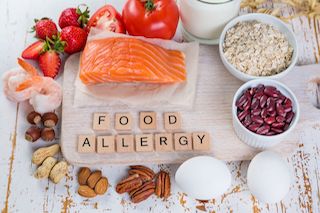Do 25% of Americans Really Have A Food Allergy?
So what do you think? Do that many people actually have food allergies? Based on several different surveys done within the last 10-20 years, the public perceives that 20 to 25% of the population has food allergies. But the truth is that only 4-8% of children and 2-4% of adults truly have an allergy to a food or foods. Therefore, the answer to the title question is that one-quarter of the population does NOT have food allergies! So the next time your friend tells you he has an allergy to a food, you should think twice.
Why do so many people believe that they have a food allergy? In my experience and in the experience of my allergy colleagues, the answer is that the word “allergy” is a very over-used term. In fact, it seems to be used whenever anyone has a “bad” or uncomfortable reaction to anything. For instance, if someone gets a headache after drinking red wine, they assume that it is an allergy (most of the time, this particular reaction is not an allergy!). Over time, all bad reactions start to get incorrectly labeled as “allergic reactions” and the prevalence of what is thought to be allergies (including food allergies) goes up.
In fact, true food allergies primarily involve two very specific types of relatively uncommon chemical reactions that occur within the immune system when the body is exposed to a particular food. One type of true food allergy reaction involves a protein called immunoglobulin E and the other type involves a white blood cell known as the T cell.
The immunoglobulin E reaction happens relatively quickly after exposure to the “trigger/allergic” food. (Usually, exposure refers to eating or drinking the food but for some people, touching or inhaling food particles from the air can be enough of an exposure to cause a reaction.) This response causes an overreaction of the immune system which can lead to symptoms such as itching, hives, lip or tongue swelling, dizziness, vomiting, diarrhea, and/or trouble breathing, among other things.
This is the type of allergic response that could be very serious and potentially fatal. This scary reaction (called anaphylaxis) is the reaction that you may have heard happening to people who are allergic to shellfish or peanut and accidentally get exposed. The best treatment is the immediate administration of adrenaline (epinephrine), lying down and putting your feet up, and calling 911 for further care.
The T cell type of food allergy reaction tends to happen hours after exposure to the “trigger” food and can have more GI (gastrointestinal) related symptoms such as abdominal discomfort, nausea, bloating, etc…
In this country, 90% of true food allergies are caused by one of the following: soy, cow’s milk (dairy), egg, peanuts, nuts, fish, shellfish.
So what about the other “bad” reactions to food that are mistaken for allergies? What most people believe to be allergies are actually food intolerances. And food intolerances are much more common than actual food allergies! What is important here is that food intolerances are NOT allergies and therefore do not occur because of the allergic reactions above. They can, however, make you feel awful. And, just to make things more complicated, sometimes the symptoms of food intolerances and food allergy (especially the T-cell type food allergy) are similar.
Food intolerance reactions usually happen in the digestive tract. One type of food intolerance occurs when the body is unable to digest a certain component of a particular food. An example of this would be lactose intolerance. Lactose intolerance literally has to do with the fact that an enzyme needed to completely digest a component of dairy foods is missing. So, when someone with lactose intolerance consumes milk, they feel bad. The underlying reaction in lactose intolerance is different from the underlying reaction that causes allergies, so lactose intolerance is not the same thing as a milk allergy.
One may also have a food intolerance known as a food “sensitivity.” This is a very poorly defined phenomenon where a person experiences some sort of unpleasant, non-allergic chemical reaction to some additive or naturally occurring chemical within in the food. Again, this is not the same reaction as a true allergy reaction and therefore is not a food allergy, but it still makes you feel bad. Food poisoning can also be considered a food intolerance. And although irritable bowel syndrome could be considered a food intolerance, there are other factors involved with that particular diagnosis. Emotional stress causing GI issues can also broadly be considered a food intolerance but has other contributing factors, too.
Perhaps the most frustrating fact is that many times, we (allergists) are not sure of the particular non-allergic trigger that leads to a food intolerance. There are simply lots of non-allergic, food-related reactions that lead to miserable GI symptoms for which we just do not have an explanation.
So remember, that a true food allergy has to do with reactions within your immune system whereas food intolerances (of which there are many) have to do with reactions in the digestive system. Food allergies can be very serious and potentially life-threatening. In contrast, many times people with food intolerances can eat tiny amounts of the culprit food without any problems!
The reason for discussing this today is to stress the importance of going to your allergist if you think you have a food allergy. Your allergist can help you figure out whether you have a true food allergy or a food intolerance and develop a plan to help you with either!
About Faria Khan MD
Dr. Khan is a board-certified pediatric and adult allergy and asthma specialist practicing with Georgia’s Allergy and Asthma Institute.
Dr. Khan is a member of both the American Academy of Allergy, Asthma, and Immunology and the American College of Allergy, Asthma, and Immunology. She has a special interest in allergic rhinitis, allergic conjunctivitis, asthma, food allergies, and allergic skin conditions.







